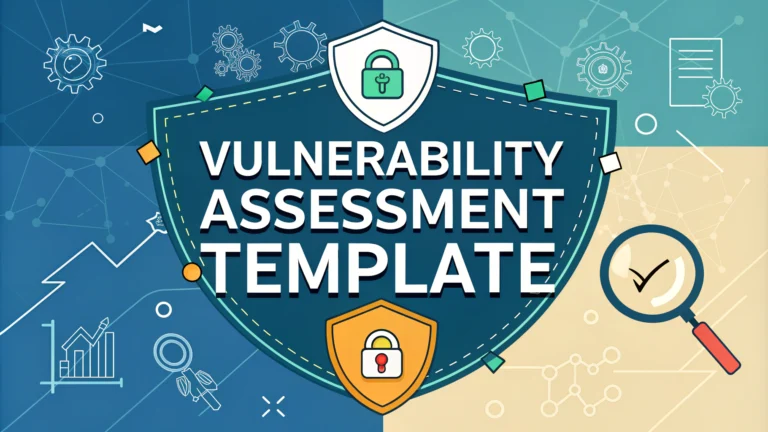A vulnerability assessment template helps organizations identify, analyze, and document security weaknesses in their systems, networks, and applications.
Security teams use these templates to maintain consistency across assessments and ensure no critical areas are overlooked during penetration testing engagements.
This guide outlines key components of an effective vulnerability assessment template and provides practical examples for implementation.
Essential Template Components
- Executive Summary
- Scope Definition
- Methodology
- Findings & Risk Ratings
- Remediation Recommendations
- Technical Details
- Appendices
Executive Summary Section
The executive summary should provide a clear overview of assessment objectives, key findings, and recommended actions.
- Assessment date and duration
- Testing team composition
- High-level risk overview
- Critical findings summary
- Business impact analysis
Scope Definition Components
- IP ranges and domains
- Applications and services
- Testing limitations
- Excluded systems
- Testing windows
Risk Rating System
| Severity | Description |
|---|---|
| Critical | Immediate exploitation risk with severe impact |
| High | Significant vulnerability requiring prompt attention |
| Medium | Moderate risk with potential for compromise |
| Low | Minor issues with minimal impact |
Documentation Requirements
- Screenshots of findings
- Proof of concept code
- Network diagrams
- Testing logs
- Tool outputs
Remediation Planning
- Prioritized fix recommendations
- Required resources
- Estimated timelines
- Technical solutions
- Validation steps
Template Customization Tips
- Align with industry standards (OWASP, NIST)
- Include company-specific requirements
- Add compliance frameworks
- Consider audience technical expertise
Tools Integration
Popular vulnerability scanning tools that integrate well with assessment templates include:
- Nessus Professional
- Acunetix
- Burp Suite Enterprise
- Qualys Vulnerability Management
- Rapid7 InsightVM
Next Steps for Implementation
Contact [email protected] for template samples and implementation guidance.
Review industry frameworks like NIST SP 800-115 for additional template components.
Schedule regular template reviews to maintain effectiveness and relevance.
Quality Assurance Process
- Regular template review cycles
- Stakeholder feedback integration
- Version control management
- Historical assessment comparison
- Effectiveness metrics tracking
Reporting Best Practices
Format Standards
- Consistent terminology usage
- Clear issue categorization
- Visual data representation
- Technical writing guidelines
- Executive-friendly summaries
Distribution Protocol
- Access control measures
- Confidentiality markings
- Stakeholder communication plan
- Follow-up procedures
Template Maintenance
- Quarterly review schedule
- Change management process
- Update documentation
- Team training requirements
- Feedback incorporation system
Advancing Security Through Standardization
Regular template updates and standardized assessment processes strengthen an organization’s security posture. Focus on continuous improvement and industry alignment ensures vulnerability assessments remain effective and relevant to emerging threats.
- Maintain template currency
- Foster team collaboration
- Track assessment metrics
- Adapt to new threats
- Build security maturity
FAQs
- What is a Vulnerability Assessment Template?
A vulnerability assessment template is a structured document that outlines the methodology, scope, and procedures for identifying, classifying, and prioritizing security vulnerabilities in an organization’s systems, networks, and applications. - What are the key components of a Vulnerability Assessment Template?
The key components include scope definition, asset inventory, vulnerability scanning parameters, risk assessment criteria, remediation guidelines, reporting format, and compliance requirements. - How often should vulnerability assessments be performed?
Vulnerability assessments should be performed quarterly for critical systems, monthly for public-facing assets, and after any significant infrastructure changes or security incidents. - What tools are commonly used in vulnerability assessments?
Common tools include Nessus, OpenVAS, Qualys, Acunetix, Burp Suite, Nmap, and Metasploit for different aspects of vulnerability scanning and assessment. - What’s the difference between a vulnerability assessment and penetration testing?
Vulnerability assessment identifies and lists potential security weaknesses, while penetration testing actively exploits these vulnerabilities to demonstrate potential attack paths and real-world impacts. - What should the vulnerability severity rating system include?
The severity rating system should include Critical, High, Medium, Low, and Informational classifications, based on CVSS scoring and potential business impact. - How should vulnerabilities be prioritized for remediation?
Vulnerabilities should be prioritized based on severity level, exploitation likelihood, potential business impact, affected asset criticality, and available remediation resources. - What compliance standards should be considered in the template?
Key compliance standards include PCI DSS, HIPAA, ISO 27001, NIST SP 800-53, GDPR, and industry-specific regulations relevant to the organization. - What should the vulnerability assessment report include?
The report should include an executive summary, methodology, detailed findings, risk ratings, technical details, remediation recommendations, and timeline for fixes. - How should false positives be handled in the assessment process?
False positives should be verified through manual testing, documented with evidence, and maintained in a knowledge base to improve future scanning accuracy.







